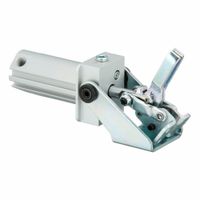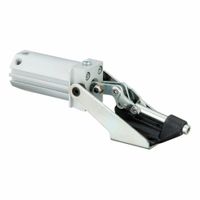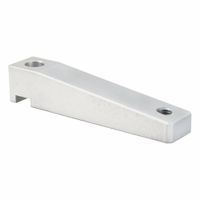Call +(254) 703 030 000 / 751 483 999 / 721 704 777
- Home
- Machining
- Clamping Workholding Positioning
- Air Powered Swing Toggle Clamps
.....Read More
Frequently Asked Questions
What are air-powered swing and toggle clamps used for?
Air-powered swing and toggle clamps are used in various industrial and manufacturing applications to securely hold workpieces in place during machining, assembly, or inspection processes. These clamps are powered by compressed air, which allows for quick and efficient operation, reducing manual effort and increasing productivity.
Swing clamps are designed to rotate into position over the workpiece and then clamp down, providing a secure hold. They are particularly useful in applications where space is limited or where the clamping area needs to be clear for loading and unloading parts. The swinging motion allows for easy access to the workpiece, making them ideal for repetitive tasks in automated systems.
Toggle clamps, on the other hand, use a pivot and lever mechanism to apply clamping force. They are known for their high holding capacity and are often used in applications requiring strong, consistent clamping pressure. Air-powered toggle clamps can be quickly engaged and disengaged, making them suitable for high-volume production environments where speed and reliability are crucial.
Both types of clamps are commonly used in automotive, aerospace, metalworking, and woodworking industries. They help ensure precision and consistency by holding parts securely in place, reducing the risk of movement or misalignment during processing. Additionally, the use of air power allows for remote operation and integration into automated systems, further enhancing efficiency and safety in the workplace.
How do air-powered clamps differ from mechanical clamps?
Air-powered clamps, also known as pneumatic clamps, differ from mechanical clamps in several key ways:
1. **Power Source**: Air-powered clamps use compressed air as their power source, while mechanical clamps rely on manual force or mechanical leverage.
2. **Operation**: Pneumatic clamps are operated using air pressure, which allows for quick and consistent clamping action. Mechanical clamps require manual adjustment and tightening, which can be time-consuming and inconsistent.
3. **Speed and Efficiency**: Air-powered clamps can engage and disengage rapidly, making them ideal for high-volume production environments. Mechanical clamps are generally slower to operate, as they require manual intervention.
4. **Consistency**: Pneumatic clamps provide consistent clamping force, as the air pressure can be precisely controlled. Mechanical clamps may vary in force depending on the operator's strength and technique.
5. **Automation**: Air-powered clamps can be easily integrated into automated systems, allowing for seamless operation in automated production lines. Mechanical clamps are typically used in manual or semi-automated processes.
6. **Force Control**: The clamping force in pneumatic clamps can be adjusted by regulating the air pressure, providing flexibility for different applications. Mechanical clamps have a fixed clamping force determined by their design and the manual force applied.
7. **Maintenance**: Pneumatic clamps require maintenance of the air supply system, including compressors and hoses. Mechanical clamps require less maintenance but may need regular inspection for wear and tear.
8. **Cost**: Air-powered clamps can be more expensive initially due to the need for a compressed air system. However, they can offer cost savings in labor and increased productivity over time. Mechanical clamps are generally less expensive upfront but may incur higher labor costs.
9. **Applications**: Pneumatic clamps are suited for repetitive, high-speed operations, while mechanical clamps are often used in applications where precision and manual control are required.
What are the benefits of using air-powered clamps in production environments?
Air-powered clamps, also known as pneumatic clamps, offer several benefits in production environments:
1. **Increased Efficiency**: Pneumatic clamps operate quickly and consistently, reducing cycle times and increasing throughput. Their rapid actuation speeds up processes compared to manual clamping.
2. **Consistent Clamping Force**: They provide uniform clamping pressure, ensuring consistent quality and reducing the risk of product defects due to uneven clamping.
3. **Reduced Operator Fatigue**: By automating the clamping process, air-powered clamps minimize the physical effort required from operators, reducing fatigue and the risk of repetitive strain injuries.
4. **Enhanced Safety**: These clamps can be integrated with safety systems to ensure they only operate under safe conditions, reducing the risk of accidents.
5. **Versatility**: Pneumatic clamps can be easily adjusted for different sizes and shapes of workpieces, making them suitable for a variety of applications and adaptable to changes in production requirements.
6. **Space Efficiency**: They often have a compact design, allowing them to be used in tight spaces where manual clamps might be impractical.
7. **Low Maintenance**: With fewer moving parts compared to hydraulic systems, pneumatic clamps generally require less maintenance, leading to lower downtime and maintenance costs.
8. **Energy Efficiency**: Air-powered systems can be more energy-efficient than hydraulic systems, especially when integrated with energy-saving technologies like air recovery systems.
9. **Integration with Automation**: Pneumatic clamps can be easily integrated into automated systems, enhancing the overall automation of production lines and improving productivity.
10. **Cost-Effectiveness**: Over time, the efficiency and reduced labor costs associated with pneumatic clamps can lead to significant cost savings.
These benefits make air-powered clamps a valuable tool in enhancing productivity, safety, and quality in production environments.
How do you maintain air-powered swing and toggle clamps?
To maintain air-powered swing and toggle clamps, follow these steps:
1. **Regular Inspection**: Frequently check for wear and tear, especially on moving parts. Look for signs of corrosion, cracks, or deformation.
2. **Lubrication**: Apply appropriate lubricants to pivot points and moving parts to reduce friction and wear. Use manufacturer-recommended lubricants to ensure compatibility.
3. **Air Supply Maintenance**: Ensure the air supply is clean and dry. Use filters and dryers to prevent moisture and debris from entering the system, which can cause damage or reduce efficiency.
4. **Check Air Pressure**: Regularly verify that the air pressure is within the recommended range. Incorrect pressure can lead to malfunction or damage.
5. **Seal Inspection**: Examine seals and gaskets for leaks or damage. Replace any compromised seals to maintain proper air pressure and prevent leaks.
6. **Cleaning**: Keep the clamps clean from dust, debris, and other contaminants. Use a soft brush or cloth to wipe down surfaces and prevent buildup that can impede function.
7. **Fastener Tightening**: Periodically check and tighten all fasteners to ensure they are secure. Loose fasteners can lead to misalignment or failure.
8. **Function Testing**: Regularly test the clamps to ensure they operate smoothly and effectively. Listen for unusual noises or irregular movements that may indicate a problem.
9. **Component Replacement**: Replace worn or damaged components promptly to prevent further damage and ensure optimal performance.
10. **Documentation**: Keep a maintenance log detailing inspections, repairs, and replacements. This helps track the condition of the clamps and plan future maintenance.
By adhering to these maintenance practices, you can extend the lifespan of air-powered swing and toggle clamps and ensure their reliable operation.
What are the different types of air-powered clamps available?
Air-powered clamps, also known as pneumatic clamps, are devices that use compressed air to hold or secure objects in place. Here are the different types:
1. **Toggle Clamps**: These clamps use a pivot and lever system to apply pressure. They are ideal for repetitive clamping tasks and are available in various configurations, such as horizontal, vertical, and push-pull.
2. **Swing Clamps**: These clamps have an arm that swings into position to apply pressure. They are suitable for applications where space is limited and are available in both single and double-acting models.
3. **Pin Clamps**: Designed for precise positioning, pin clamps use a retractable pin to secure workpieces. They are often used in automotive and sheet metal applications.
4. **Work Support Clamps**: These provide support to workpieces during machining or assembly. They can adjust to different heights and are used to prevent workpiece deflection.
5. **Gripper Clamps**: These clamps use jaws to grip and hold objects. They are commonly used in automation and robotic applications for handling parts.
6. **Power Clamps**: These are robust clamps used for heavy-duty applications. They provide high clamping force and are often used in welding and assembly operations.
7. **Vacuum Clamps**: Utilizing vacuum pressure, these clamps hold workpieces without marring the surface. They are ideal for delicate or irregularly shaped items.
8. **Parallel Clamps**: These clamps maintain parallelism between the clamping surfaces, ensuring even pressure distribution. They are used in woodworking and metalworking.
9. **Squeeze Action Clamps**: These clamps use a squeezing mechanism to apply pressure. They are quick to operate and are used in light-duty applications.
10. **Pneumatic Vises**: These are similar to traditional vises but use air pressure for operation. They provide strong and consistent clamping force.
Each type of air-powered clamp is designed for specific applications, offering various advantages in terms of speed, force, and precision.
How do you choose the right air-powered clamp for a specific application?
To choose the right air-powered clamp for a specific application, consider the following factors:
1. **Application Requirements**: Determine the specific tasks the clamp will perform, such as holding, positioning, or assembling parts. Understand the operational environment, including temperature, humidity, and exposure to chemicals or debris.
2. **Clamping Force**: Calculate the necessary clamping force based on the materials and the nature of the workpiece. Ensure the clamp can provide sufficient force to hold the parts securely without causing damage.
3. **Size and Weight**: Consider the size and weight of the workpieces. Choose a clamp that can accommodate the dimensions and weight without compromising performance or safety.
4. **Type of Clamp**: Select the appropriate type of clamp (e.g., toggle, swing, or linear) based on the movement and positioning required. Each type offers different advantages in terms of speed, precision, and ease of use.
5. **Cycle Time**: Evaluate the required cycle time for the application. Ensure the clamp can operate at the necessary speed to meet production demands without overheating or wearing out prematurely.
6. **Air Pressure and Consumption**: Check the available air pressure and consumption rates. The clamp should be compatible with the existing pneumatic system to ensure efficient operation.
7. **Durability and Maintenance**: Consider the durability of the clamp materials and design. Opt for clamps that require minimal maintenance and have a long service life to reduce downtime and costs.
8. **Safety Features**: Ensure the clamp includes necessary safety features, such as pressure relief valves or emergency stop functions, to protect operators and equipment.
9. **Cost and Budget**: Balance the cost of the clamp with the budget constraints while ensuring it meets all operational requirements.
10. **Manufacturer Support**: Choose a reputable manufacturer that offers technical support, warranty, and replacement parts to ensure long-term reliability and service.
What are common issues with air-powered clamps and how can they be resolved?
Common issues with air-powered clamps include:
1. **Air Leaks**: Air leaks can reduce clamping force and efficiency. To resolve this, regularly inspect hoses, fittings, and seals for wear or damage and replace them as needed. Use soapy water to detect leaks.
2. **Inconsistent Clamping Force**: Variations in air pressure can lead to inconsistent clamping. Ensure the air supply is stable and regulated. Install pressure regulators and maintain them to provide consistent pressure.
3. **Slow Response Time**: This can be due to long air lines or insufficient air supply. Shorten air lines where possible and ensure the air supply system is capable of delivering the required volume and pressure.
4. **Wear and Tear**: Moving parts can wear out over time. Regularly inspect and maintain components such as pistons, seals, and cylinders. Lubricate moving parts to reduce friction and wear.
5. **Contamination**: Dirt and moisture in the air supply can cause malfunction. Use air filters and dryers to keep the air clean and dry. Regularly check and replace filters.
6. **Misalignment**: Misaligned clamps can cause uneven clamping and damage to workpieces. Ensure proper alignment during installation and regularly check alignment during maintenance.
7. **Overloading**: Exceeding the clamp's capacity can lead to failure. Use clamps within their specified limits and consider using multiple clamps for larger loads.
8. **Noise**: Excessive noise can indicate leaks or mechanical issues. Address leaks and ensure all components are functioning properly to reduce noise.
By addressing these issues through regular maintenance, proper installation, and ensuring a clean and stable air supply, the performance and lifespan of air-powered clamps can be significantly improved.




